
photo taken from wikipedia
6 major jumps
In line with the 2018 Pyeongchang Winter Olympic Games that opened on the 8th of February, I would very much like to highlight the figure skating event, being a figure skater myself. As a winter athlete in a tropical country, I find that my sport does not get enough recognition and the majority of the masses aren't really interested with the technicalities of my sport. Quite a number of people frequently react to figure skating as "boring" with the repeated use classical music, and of course it being a "feminine" sport, which is ironic due to the fact that men are currently the ones excelling in it.
From my observation, the biggest thing that people are ultimately confused of are the jumps. And yes, THEY ARE DIFFERENT. What makes it least obvious is the technicalities that lead to the jump. Which edge to take off from, which direction you're coming from, which toe to tap the ice with, etc. It is confusing to learn about such jumps when you haven't tried executing it and especially when you're merely watching. You will also learn that figure skating jumps have history, too.
This might contain a lot of technicalities that are not familiar to you, I will be doing my best provide in-depth explanations
Before we dwell on that, I would like to first show that different parts of a figure skating blade and skating jargons, this will make explaining the jumps and other technicalities easier.

- The plates are the part attached to the skates and have holes for the screw to come through.
- The Toe rake or most commonly known as the Toe pick is that front most tip part of the blade and is used to assist a skater when doing jumps.
- The rocker is where a skater puts pressure on when stroking on the ice.
- Spinning rocker or what people commonly call the Ball of a blade is where a skater puts his/her weight as they spin. It is where the curvature of the blade is, it has a slippery feeling to it which makes it suitable for spinning.
- The Tail of a blade helps support jump landings.
- Even though a figure skate blade looks like there is one edge, there are actually two, an inner edge (toward your inner thigh) and the outer edge (outer thigh). Depending on what a skater is wanting to do they will use the inside or outside edge to accomplish their task.
More Technicalities:
- Three-turn is a figure skating element which involves both a change in direction and a change in edge. There are 2 kinds: Inside Edge and Outside Edge 3 turns. For example, a skater may start on the right foot, forward inside edge, and finishes on the same foot but on a backwards outside edge. Take not that this is a one-foot turn.


Here, Olympic champion, Yuna Kim, enters her jump with a left forward outside edge and finished on the left backwards inside edge before jumping. This is what a forward outside 3 turn looks like.
- A Crossover is basically the technique ice skaters use to move around corners. The skater is trained to cross the outside skate over the skate that is on the inside of the curve. This is used by figure skaters to gain momentum while skating in a curve of circular fashion. It can be performed forwards or backwards. This is also done is both directions, Left or Right.

Toe Pick Jumps

.gif)
The Toe Pick is that front most tip part of the blade. It can come in different sizes and style, but most of all it's pointy. The primary use of the toe pick are for jumping, footwork, and spins, and by all means should NOT be used for stroking in the ice.
I've seen a lot of public skaters with the same common misconception: toe picks are for pushing themselves. It's not and using your toe pick to glide on the ice could result to it getting caught on the ice and you falling face first, please avoid doing so at all cost.
Toe Loop
Each jumps differ in which foot to assist the skater with and also the entrance or preparation a skater does before taking on the jump. The toe loop is one of the simplest jumps in figure skating. The skater enters with a right forward inside edge, then taps the left toe pick on the ice for take off and landing on the right foot.


Flip
The flip jump is a figure skating jump which takes off from a left outside 3-turn, once in the backward inside edge, continue with a right toe pick assist, and land on the backward outside edge of the opposite foot.



Lutz
The Lutz is a figure skating jump very similar to a flip, assisted by the right toe pick. It's the entrance and edges that's tricky. You enter the jump from a backward crossover, staying on the left outside edge of the blade before the take off and landing on a backwards outside edge as well.

People often confuse a Lutz with a Flip due to the right toe pick assist, but the kind of jump can be determined by their entrances. A Flip enters with a left outside 3-turn, staying on the left inside edge before the take off, while the Lutz enters with the skater going backwards and just staying on the left outside before taking off. The Lutz can be a tricky jump and if you fail to stay on the left outside edge, in figure skating jargon we call it a Flutz or a Failed Lutz.
As early as the entrance, people will know that a skater will be attempting a lutz. It's tricky because this jump has you taking off on the outside edge, which means that your blades' direction will be diagonally leaning to the left, contradicting your counter-clockwise rotation. It's a pretty scary jump for me.
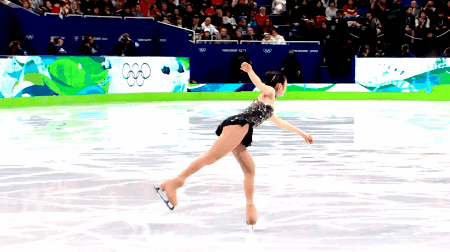
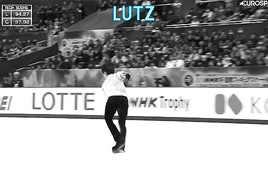
Fun Fact: The Lutz was invented by an Austrian skater named Alois Lutz, who first performed it in competition in 1913.
Edge Jumps
The difference between an Edge Jump and a Toe Jump is that Edge jumps don't need any assistance from the other foot and takes of directly as is.
Loop
The Loop is the first full one revolution jump you'll learn as a figure skater. Typically, skaters enter on a right inside 3-turn, staying on the backwards outside edge while drawing the left foot (still on the ice) to cross in front of the right. Knees are deeply bent, to support the jump. The skater then draws their arms in a circle while simultaneously springing to a jump from that bent knee and landing on the right outside edge.




Salchow
The Salchow is a jump that can be entered using a Mohawk or through a left outside 3-turn. After the 3-turn, the skater stays on their left backwards inside edge, and taking the free foot up in a scooping motion as they simultaneously take off for the jump, lading it on a right backwards outside edge. The scooping motion helps the skater gain momentum for the revolution of the jump.
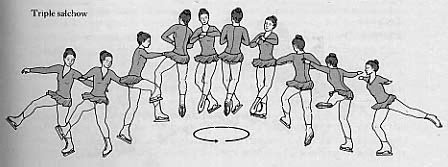


Fun Fact: This jump was invented by a Swedish figure skater named Ulrich Salchow. He dominated the sport in the early 1920's, and I'm not even exaggerating the fact that he won world championships 10 times and European champion 9 times.
Axel
The Axel is by far, the scariest and technically the most difficult jump in figure skating due to the fact that it's the only jump with a forward take off. Not only does it have a forward entrance, unlike all the other jumps where all the revolutions were even, compared to other common figure skating jumps, an Axel has an extra ½ rotation in the air because of its forward take off. That means that a single axel actually has one and a half revolutions, two and half for a double axel, and three and half revolutions for a triple axel.
Skaters take off from the left forward outside edge, and throwing the free foot forward as they jump, and then landing on the right backward outside edge.


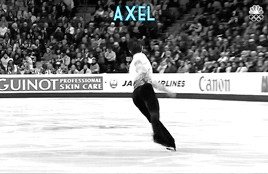
Fun Fact: The Axel was invented by a Norwegian figure skater and speed skater, Axel Paulsen. He is also renowned for being able to perform a program while on speed skates, which is shaped differently and is way thinner than a figure skating blade.
And there you have it folks!
Those are the major jumps in figure skating and officially recognized by the ISU (Ice Skating Union). These jumps all have base points. If you land them, there's already a base point for that and if you landed and executed well, we have an additional GOE (Grade of Execution) which is similar to bonus points. Athlete train there hardest to be able to execute these jumps. Pushing themselves beyond boundaries, to be able to achieve an almost superhuman skill. Figure skating looks beautiful on the ice, but it's brutal on the body.
The least we can do to honor our athletes is to get ourselves to know what it is they're working so hard for. To the point of pushing their bodies to the limit, sacrificing a normal life to live an athlete's life. The sense of pride that we have when we see them walking on Olympic soil. This goes to all types of sports, Winter or Summer. Let's all take pride in our athletes and wish them the best at the Olympics!
Additional Facts:
- Figure Skaters land on their toe picks.

- A figure skater absorbs 7 times their weight after landing a jump. Imagine the strain on your knees.
- Figure skaters cross their legs and close their arms towards their bodies mid air, reducing the inertia, and causes the skater to spin or rotate faster.
- You do not want to be anywhere near a figure skater as they land the jump due to the enormous pressure it has on the ice. You can hearing a loud thump once they've landed a jump, and feel like the ice moved.
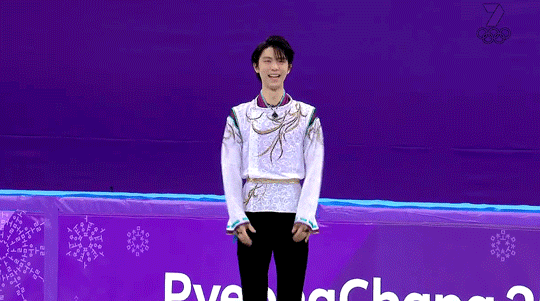
I hope I've done my best to introduce to you guys a much more complex explanation of my beloved sport. I also hope that it sheds light to all your questions about figure skating and if you have more please don't hesitate to comment on this post. Thank you all so much for taking your time! All the love! xx
Photo Credits:
http://yuzuruhanyuedits.tumblr.com/post/154791035628/part-i-jump-identification-part-ii-jump http://icedoesntcare.blogspot.com/ https://www.yahoo.com/news/gif-guide-figure-skaters-39-jumps-olympics-171900531.html
It's very interesting post. Thank you for your work!
Please come in. Thank's. https://steemit.com/steemiteducation/@arafatnur/let-s-learn-and-write
So much technicallities and all you ever hear in movies is the axel, maybe cuz it sound cooler than the lutz 😅. I was expecting you to demo all the jumps tho HAHAH.
probs cuz the axel is the most difficult jump, literally and technically. nobody wants to do a lutz, it's too difficult ;-; i was thinking of doing so, but when I started writing, my blades weren't sharp enough to be able to perform and i've only just gotten them sharpened yesterday, so maybe next time :D
That was quite an informative read. If i am to try figure skating now, I would most probably land a flutz haha. Learned something new today. Awesome article!
WOW you're better then me, I can't even land a Flutz lol it's the entrance to the jump that makes it hard too, you're traveling on a straight line instead of a curve towards the take off, it doesn't give you much momentum ;-;
LOL just kidding, I wouldn't last being a skater but I would really love to learn from you soon - after all the sh*t in school is done. It would take a while but it's going to happen soon enough
Thank's. Look me in here https://steemit.com/steemiteducation/@lingi/patience-facing-naughty-children
At first i did not want to read this because i have tried this several times and i do fail. i have injured my times severally.
but now i just learn something.
thank you very much.
You can also learn somethings from me.
We all fail in the the beginning, all that's needed it more practice and dedication! I'm so glad I was able to help you, my goal was for this article to be able educate as much people as possible. :D
Very interesting. Thank you
No problem! :)
wow! congrats,well deserved🎉🎉🎉
I learned just yesterday that ice skating was at first, all about stiff and rigid movements. Because of this write-up, I've learned more about the sport! Keep at it, @pizzanniza